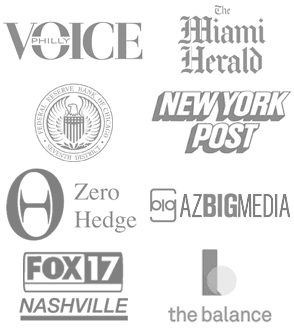Refinancing a house can lower payments, reduce interest rates, shorten loan terms, or access equity. In 2025, economic conditions and personal finances determine if it’s the right move. Let’s explore home refinancing in 2025, covering market trends and consider the pros and cons. The RefiGuide will review the top banks and mortgage lenders to refinance a house this year.
How Do Home Refinance Rates Look in 2025?
Refinancing mortgage rates in 2025 reflect economic trends, Federal Reserve actions, and lender dynamics, impacting homeowners’ refinancing decisions.
As of September 2025, rates are lower than 2023 highs, benefiting those with high-rate loans from 2022-2023.
Current Home Refinance Rates
Per Bankrate’s July 8, 2025, survey, the average 30-year fixed refinance rate is 6.80% (6.85% APR), and the 15-year fixed rate is 6.14% (6.23% APR). The 5/1 ARM refinance rate averages 6.08%, and jumbo loans (over $806,500) are at 6.82%. Refinance rates are down from 2024’s 6.7% average but far from 2021’s 2.65% low. VA IRRRL rates start at 5.875%, while FHA Streamline rates include mortgage insurance. Find the best refinance mortgage rates.
Factors Influencing Rates
-
Federal Reserve Policy: Post-2024 rate cuts, the Fed paused, but Fannie Mae predicts 6.3% by Q4 2025 with two potential cuts. Inflation above 2% may delay reductions.
-
Economic Conditions: Stable growth keeps rates near 6.7%, per the Mortgage Bankers Association. A recession could lower rates, but none is forecast.
-
Borrower Profile: Scores above 720 and LTVs below 80% yield better rates. Discount points (1% of loan) cut rates by ~0.25%.
-
Lender Competition: Online lenders and credit unions offer rates below averages, with incentives like waived fees.
Considerations for Homeowners
Homeowners with 7%+ loans benefit most. Home refinancing a $400,000 loan from 7.25% to 6.75% saves $167 monthly. Closing costs (2-5% of loan) require a 2-3-year break-even, unsuitable for short-term stays. Low-rate (sub-4%) borrowers from 2020-2021 may opt for cash-out refinancing for equity access. The RefiGuide will help you compare refinance lenders and explore high-LTV programs with no application fee.
Economic and Mortgage Market Trends in 2025
Interest Rates for Home Refinancing
In 2025, 30-year fixed mortgage rates average 6.2%, down from 7.8% in 2023, per Freddie Mac. Fifteen-year rates are 5.5%, and 5/1 ARMs start at 4.8%. Federal Reserve rate cuts signal lower rates, but volatility persists. Homeowners with 7%+ loans from 2022-2024 benefit most.
Home Values and Equity
Home prices rose 2% year-over-year, with regional differences (4% in Sun Belt, flat in Northeast). Stable values support cash-out refinancing. High-LTV programs (VA, FHA) help low-equity borrowers.
Inflation and Cost of Living
Inflation, though cooling, pressures budgets. Refinancing can lower payments, but closing costs (2-5% of loan) require long-term commitment.
Mortgage Lender Competition
Lenders offer competitive terms, like no-appraisal VA/FHA loans or reduced fees, favoring borrowers with 700+ credit scores.
Key Considerations for Home Refinancing
-
Rate Difference: Lowering your rate by 0.5-1% saves significantly (e.g., 7.5% to 6.2% on $300,000 saves $200/month).
-
Break-Even: Divide closing costs by monthly savings (e.g., $6,000 ÷ $200 = 30 months).
-
Loan Term: Shorter terms save interest; longer terms cut payments.
-
Credit/Income: Need 620+ credit, DTI <43%.
-
Purpose: Rate-and-term adjusts payments; cash-out funds other needs.
Pros and Cons of Home Refinancing in 2025
Pros
-
Rates below 6.5% beat 2023 highs.
-
VA/FHA programs aid low-equity borrowers.
-
Equity supports cash-out for renovations/debt.
-
Lower payments ease inflation strain.
Cons
-
Closing costs offset short-term savings.
-
ARMs risk rate hikes.
-
Stricter standards challenge low-credit borrowers.
-
Cash-out reduces equity.
Case Study 1: Lowering Monthly Payments
Profile: Sarah, 38, San Diego, CA
Situation: $400,000 home, 2022 30-year loan at 7.2% ($2,716/month). Credit: 740. Home value: $420,000. Needs lower payments.
Decision: Refinances to 6.2% 30-year fixed ($2,444/month), $8,000 costs. Saves $272/month; break-even: 29 months.
Outcome: Long-term savings help with inflation. Strong credit secured low rate.
Lesson: Ideal for high-rate loan holders staying long-term.
Case Study 2: Cash-Out for Home Improvements
Profile: Martinez Family, Atlanta, GA
Situation: $350,000 home, 2020 FHA loan at 3.5% ($1,571/month). Value: $410,000. Needs $40,000 for kitchen. Credit: 680, DTI: 38%.
Decision: Cash-out $390,000 at 6.5% ($2,465/month), $9,000 costs. Nets $31,000. Break-even: 48 months.
Outcome: Renovations add $50,000 value. Interest tax-deductible. Payment manageable.
Lesson: Cash-out suits equity-rich homeowners with value-adding goals.
Case Study 3: Shortening Loan Term
Profile: James/Priya, Seattle, WA
Situation: $600,000 home, 2019 loan at 4.2% ($2,936/month). Value: $680,000. Paid $100,000. Credit: 760. Wants faster payoff.
Decision: Refinances $500,000 to 15-year at 5.5% ($4,086/month), $10,000 costs. Saves $150,000 interest. Break-even: 50 months.
Outcome: Mortgage-free by 2040. Higher income supports payment.
Lesson: Short-term loans fit high-income borrowers prioritizing savings.
Is 2025 the Right Time for Mortgage Refinancing?
Refinancing in 2025 suits high-rate loan holders, equity-rich borrowers, or those needing lower payments. VA/FHA programs help low-equity owners; cash-out aids renovations. Weigh costs if moving soon or if rates rise.
Steps to Take
-
Review current loan rate/term.
-
Confirm 620+ credit, DTI <43%.
-
Compare lender rates/fees.
-
Calculate savings/break-even.
-
Consult brokers/advisors.
With rates at 6.2%, stable home values, and competitive lending, 2025 favors refinancing for many. Case studies show benefits like lower payments, equity access, or faster payoffs. Analyze costs, goals, and market trends to decide if refinancing fits your needs.
Top US Mortgage Lenders for Home Refinancing in 2025 (ranked by rate competitiveness + posted/APR signals + program breadth)
-
loanDepot — Direct lender with streamlined refi flow and rate-match posture; strong presence across fixed and FHA/VA options.
-
Rocket Mortgage — Frequently posts aggressive headline rates and broad product depth; transparent daily rate cards.
-
Navy Federal Credit Union — “As low as” rates (incl. VA IRRRL) often price well for eligible members; points/origination trade-offs disclosed.
-
Chase — Competitive for strong-credit borrowers, jumbo, and relationship discounts; consistently cited among best refi lenders.
-
Bank of America — Widely available pricing with relationship benefits; strong digital rate shopping tools.
-
Better — Online-first experience with quick quotes and frequent low-APR promotions, subject to points/credits.
-
PenFed Credit Union — Member-focused pricing that can undercut banks on certain terms; good jumbo/FHA access.
-
PNC Bank — Broad footprint and competitive fixed-rate refi options; regularly appears in best-of rundowns.
-
U.S. Bank — Consistent national pricing and relationship discounts; solid for conforming and jumbo refis.
-
Truist — Regional strength with competitive specials; worth a quote for Southeast and Mid-Atlantic borrowers.
Method in 60 seconds. We prioritized publicly posted/advertised rate cards (and APRs when shown), recent media rate snapshots to anchor market context, and independent “best refinance lender” lists to confirm breadth and consistency. Because APR depends on points and fees, a lender ranked lower here may beat others for your specific profile, day, or lock period. Always compare same-day, same-points Loan Estimates before deciding.
Pro tip: We suggest getting 2–4 home refinance quotes (one bank, one credit union, two non-bank lenders) on the same morning, price at zero-point and 1-point scenarios, and ask for a 45-day lock with a free float-down. That apples-to-apples approach exposes the true lowest offer.

